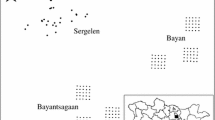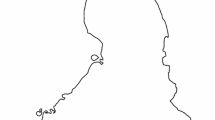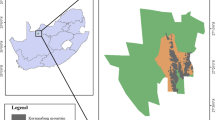Abstract
In this paper, we describe and analyze the diet of peregrine falcons during a long-term period (1982–2002). A combination of direct observations of prey brought to nests, prey remains, and regurgitated pellets were used to calculate diet diversity and dietary overlap between peregrine pairs. We also examined diet diversity in relation to breeding performance. All peregrine pairs fed mainly on birds, with pigeons the most common prey. An increase in pigeon availability has been associated with both an increase in population size and an increase in breeding performance (measured as the average productivity of pairs per year) of a small peregrine falcon population in eastern Spain. Average productivity was lower when dietary breadth was higher. We speculate that our results were the synergistic effect of declining persecution and increased pigeon availability through increased popularity of keeping racing pigeons. There is a conflict of interests between pigeon fanciers and peregrine conservation. As a consequence, this could result to an increased risk of mortality by direct persecution. In accordance with this, conservation measures aimed at preventing direct persecution are encouraged.


Similar content being viewed by others
References
Bayle P (1981) Quelques données sur le régime alimentaire du faucon pèlerin (Falco peregrinus) dans le massif vosgien. Ciconia 5:51–56
Bird DM, Aubry Y (1982) Reproductive and hunting behaviour in peregrine falcons, Falco peregrinus, in southern Quebec. Can Field Nat 96:167–171
Collopy MW (1983) A comparison of direct observations and collections of prey remains in determining the diet of golden eagles. J Wildl Manage 47:360–368 doi:10.2307/3808508
Cramp S, Simmons KEL (1980) The birds of Western Paleartic, vol. II. Oxford University Press, UK
Cramp S et al (1977–1985) Handbook of the birds of Europe, the Middle East and North Africa, vols I–IV. Oxford University Press, UK
Del Hoyo J, Elliot A, Sargatal J (1994) Handbook of the birds of the world, vol. 2. New world vultures to guineafowl. Lynx Edicions, Barcelona, Spain
Dekker D (1980) Hunting success rates, foraging habits, and prey selection of peregrine falcons migrating through central Alberta. Can Field Nat 94:371–382
Dixon A, Richards C, Lawrence A, Thomas M (2003) Peregrine (Falco peregrinus) predation on racing pigeons (Columbia livia) in Wales. In: Thompson DBA, Redpath SM, Fielding AH, Marquiss M, Galbraith CA (eds) Birds of prey in a changing environment. The Stationer Office, Edinburgh, pp 255–261
Gotelli NJ, Ellison AM (2004) A primer of ecological statistics. Sinauer, Sunderland, Massachusetts, USA
Gotelli NJ, Entsminger GL (2001) EcoSim: null models software for ecology. Version 7.0. Acquired Intelligence Inc. & Kesey-Bear. http://homepages.together.net/∼gentsmin/ecosim.htm
Gotelli NJ, Graves GR (1996) Null models in ecology. Smithsonian Institution Press, Washington DC, U.S.A
Haefner JW (1988) Niche shifts in greater Antillean Anolis communities: effects of niche metric and biological resolution on null model tests. Oecologia 77:107–117 doi:10.1007/BF00380933
Hegemann A, Hegemann ED, Krone O (2007) Trichomonosis in a free-living stock dove (Columba oenas). Eur J Wildl Res 53:235–237 doi:10.1007/s10344-007-0090-6
Henderson I, Parrott D, Moore N (2004) Racing pigeons—impact of raptor predation. Report to Scottish Natural Heritage & Scottish Homing Union. Central Science Laboratory. March 2004. http://www.snh.org.uk/pdfs/pigeons_raptors_report.pdf
Höfle U, Gortázar C, Ortíz JA, Knispel B (2004) Outbreak of trichomoniasis in a woodpigeon wintering roost. Eur J Wildl Res 50:73–77 doi:10.1007/s10344-004-0043-2
Inger RF, Colwell RK (1977) Organization of contiguous communities of amphibians and reptiles in Thailand. Ecol Monogr 47:229–253 doi:10.2307/1942516
Jenkins A, Avery G (1999) Diets of breeding peregrine and lanner falcons in South Africa. J Raptor Res 33:190–206
Jutglar F, Masó A (1999) Aves de la Península Ibérica. Editorial Planeta, S.A. Barcelona, Spain
Lawlor LR (1980) Structure and stability in natural and randomly constructed competitive communities. Am Nat 116:394–408 doi:10.1086/283634
Levins R (1968) Evolution in changing environments. Princeton University Press, Princeton, USA
Magurran AE (2003) Ecological diversity and its measurements. Princeton University Press, Princeton, NJ, USA
Mañosa S (1994) Goshawk diet in a Mediterranean area of northeastern Spain. J Raptor Res 28:84–92
Margalida A, Ecolan S, Boudet J, Bertrán J, Martínez JM, Heredia R (2006) A solar-powered transmitting video camera for monitoring cliff-nesting raptors. J Field Ornithol 77:7–12 doi:10.1111/j.1557-9263.2006.00007.x
Martí CD (1987) Raptor food habit studies. In: Giron Pendleton BA, Millsap BA, Cline K, Bird DM (eds) Raptor management techniques manual. National Wildlife Federation, Washington, DC, USA, pp 67–80
Mearns R (1983) The diet of the peregrine Falco peregrinus in south Scotland during the breeding season. Bird Study 30:81–90
Mersmann TJ, Buehler DA, Fraser JD, Seegar JKD (1992) Assessing bias in studies of bald eagle food habits. J Wildl Manage 56:73–78 doi:10.2307/3808792
Mínguez E, Pérez JM, Sanz A, Sales A, Sánchez-Zapata JA, Giménez A, Botella F (2005) Pigeon-fancying and raptor conservation in the Valencian community. Report to Conselleria Territori i Habitatge. Generalitat Valenciana, November 2005
Monneret RJ (2000) Le faucon pèlerin. Delechauux et niestle, Suisse
Newton I (1979) Population ecology of raptors. T & AD Poyser, Berkhamstead, UK
Oro D, Tella JL (1995) A comparison of two methods for studying the diet of the peregrine falcon. J Raptor Res 29:207–210
Parrott D, Henderson I, Deppe C, Whitfield P (2008) Scottish racing pigeons killed by peregrine falcons Falco peregrinus: estimation of numbers from ring recoveries and peregrine daily food intake. Bird Study 55:32–42
Pianka ER (1973) The structure of lizard communities. Annu Rev Ecol Syst 4:53–74 doi:10.1146/annurev.es.04.110173.000413
Ratcliffe DA (1993) The peregrine falcon. T & AD Poyser, London, UK
Redpath SM, Thirgood SJ (1997) Birds of prey and red grouse. H.M. Stationery Office, London
Reif V, Tornberg R (2006) Using time-lapse digital video recording for a nesting study of birds of prey. Eur J Wildl Res 52:251–258 doi:10.1007/s10344-006-0039-1
Rosenfield R, Schneider J, Papp JM, Seegar WS (1995) Prey of peregrine falcons breeding in West Grenland. Condor 97:763–770 doi:10.2307/1369184
Sale PF (1974) Overlap in resource use, and interspecific competition. Oecologia 17:245–256 doi:10.1007/BF00344924
Schoener TW (1974) Resource partitioning in ecological communities. Science 185:27–39 doi:10.1126/science.185.4145.27
Simmons RE, Avery DM, Avery G (1991) Biases in diets determined from pellets and remains: correction factors for a mammal and bird-eating raptor. J Raptor Res 25:63–67
StatSoft (2004) STATISTICA (data analysis software system), version 7. StatSoft Incorporated, Tulsa, OK, USA
Steenhof K, Kochert MN (1982) An evaluation of methods used to estimate raptor nesting success. J Wildl Manage 46:885–893 doi:10.2307/3808221
Steenhof K, Kochert MN (1985) Dietary shifts of sympatric buteos during a prey decline. Oecologia 66:6–16 doi:10.1007/BF00378546
Thiollay JM (1982) Les ressources alimentaires, facteur limitant le reproduction d’une population insulaire de faucons pèlerins, Falco peregrinus brookei. Alauda 50:16–44
Thiollay JM (1988) Prey availability limiting an island population of peregrine falcon in Tunisia. In: Cade TJ, Enderson JH, Thelander CG, White CM (eds) Peregrine falcon populations. Their management and recovery. The Peregrine Fund Inc. Boise, Idaho, USA, pp 701–710
Valkama J, Korpimäki E, Arroyo B, Beja P, Bretagnolle V, Bro E et al (2005) Birds of prey as limiting factors of gamebird populations in Europe: a review. Biol Rev Camb Philos Soc 80:171–203 doi:10.1017/S146479310400658X
Verdejo J (1991) Las aves de presa diurnas y nidificantes en el Alto Palancia (S.O Castellón). Ph.D. Thesis. Universidad de Valencia. Valencia, Spain.
Verdejo J (1994) Breeding biology and food of the goshawk (Accipiter gentilis) in a Mediterranean area. Ardeola 41:37–43
Verdejo J, López-López P (2008) Long-term monitoring of a peregrine falcon population: size, breeding performance and nest-site characteristics Ardeola 55(1):87–96
Villanúa D, Höfle U, Pérez-Rodríguez L, Gortázar C (2006) Trichomonas gallinae in wintering Common Wood Pigeons Columba palumbus in Spain. Ibis 148:641–648 doi:10.1111/j.1474-919X.2006.00561.x
Watson J (1997) The golden eagle. T. & A.D. Poyser Ltd., London, UK
Winemiller KO, Pianka ER (1990) Organization in natural assemblages of desert lizards and tropical fishes. Ecol Monogr 60:27–55 doi:10.2307/1943025
Zuberogoitia I, Fernando J, Moneo R, Torres JJ (2002) El Halcón Peregrino. Diputación Foral de Bizkaia Departamento de Agricultura, Bilbao, Spain
Acknowledgments
We would like to thank everybody who helped in the field work. Juan Manuel Pérez of the University of Elche kindly provided unpublished data about their study of pigeon fancying in the Valencian Community. Gary Entsminger kindly helped with niche overlap calculations. Clara García, Álvaro Soutullo, Miguel Ángel Gómez and Phillip Whitfield improved the English and made valuable comments on an early draft of the manuscript. P. López-López is supported by FPU grant of the Spanish Ministerio de Ciencia e Innovación (reference AEP2005-0874).
Author information
Authors and Affiliations
Corresponding author
Additional information
Communicated by C. Gortazar
Rights and permissions
About this article
Cite this article
López-López, P., Verdejo, J. & Barba, E. The role of pigeon consumption in the population dynamics and breeding performance of a peregrine falcon (Falco peregrinus) population: conservation implications. Eur J Wildl Res 55, 125–132 (2009). https://doi.org/10.1007/s10344-008-0227-2
Received:
Revised:
Accepted:
Published:
Issue Date:
DOI: https://doi.org/10.1007/s10344-008-0227-2




